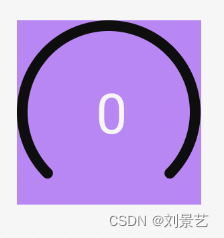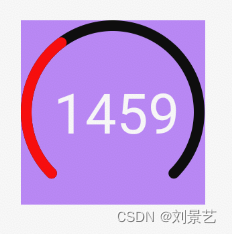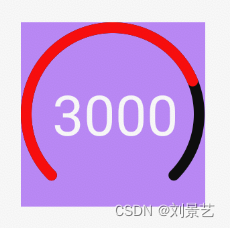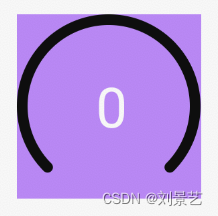话不多说,先看效果
初始状态
中间动画状态
最终状态
类似一个仪表盘,进度条从0增长到3000。
show you code :
分析图像,我们需要如下属性:
外圈颜色、内圈颜色、弧宽度、数字文本大小、数字文本颜色
<declare-styleable name="QQStepView">
<attr name="outerColor" format="color"/>
<attr name="innerColor" format="color"/>
<attr name="borderWidth" format="dimension"/>
<attr name="stepTextSize" format="dimension"/>
<attr name="stepTextColor" format="color"/>
</declare-styleable>
1.创建一个自定义View : QQStepView,让所有的构造方法都执行到同一个,并且在这个构造方法中去获取xml里设置的属性。
package com.example.view_day01;
import android.content.Context;
import android.content.res.TypedArray;
import android.graphics.Canvas;
import android.graphics.Color;
import android.graphics.Paint;
import android.graphics.Rect;
import android.graphics.RectF;
import android.util.AttributeSet;
import android.util.Log;
import android.view.View;
import androidx.annotation.Nullable;
public class QQStepView extends View {
private int mOuterColor = Color.GRAY;
private int mInterColor = Color.RED;
private int mBorderWidth = 20; //20px
private int mStepTextSize;
private int mStepTextColor;
public QQStepView(Context context) {
this(context, null);
}
public QQStepView(Context context, @Nullable AttributeSet attrs) {
this(context, attrs, 0);
}
public QQStepView(Context context, @Nullable AttributeSet attrs, int defStyleAttr) {
super(context, attrs, defStyleAttr);
//获取xml里的属性值
TypedArray array = context.obtainStyledAttributes(attrs, R.styleable.QQStepView);
mOuterColor = array.getColor(R.styleable.QQStepView_outerColor, mOuterColor);
mInterColor = array.getColor(R.styleable.QQStepView_innerColor, mInterColor);
mBorderWidth = (int) array.getDimension(R.styleable.QQStepView_borderWidth, mBorderWidth);
mStepTextSize = array.getDimensionPixelSize(R.styleable.QQStepView_stepTextSize, mStepTextSize);
mStepTextColor = array.getColor(R.styleable.QQStepView_stepTextColor, mStepTextColor);
//释放资源
array.recycle();
}
- 重写onMeasure()方法,确定view的宽高,保证是个正方形
@Override
protected void onMeasure(int widthMeasureSpec, int heightMeasureSpec) {
super.onMeasure(widthMeasureSpec, heightMeasureSpec);
//宽高不一致,取小的,保证是个正方形
int width = MeasureSpec.getSize(widthMeasureSpec);
int height = MeasureSpec.getSize(heightMeasureSpec);
setMeasuredDimension(width > height ? height : width, width > height ? height : width);
}
- 重写绘制方法onDraw(Canvas canvas)
绘制就是用Paint在一定区域内Rect绘制到Canvas上
想画什么样的图形就调用Canvas.drawxxx方法
开始画之前,要在构造方法里先初始化画笔
//初始化外部画笔
mOuterPaint = new Paint();
mOuterPaint.setAntiAlias(true);
mOuterPaint.setColor(mOuterColor);
mOuterPaint.setStrokeWidth(mBorderWidth);//width 是弧的内外扩散的
mOuterPaint.setStyle(Paint.Style.STROKE);//Fill画笔实心,Stroke描边
mOuterPaint.setStrokeCap(Paint.Cap.ROUND);//线条尾部设置成圆角
//初始化内部画笔
mInnerPaint = new Paint();
mInnerPaint.setAntiAlias(true);
mInnerPaint.setColor(mInterColor);
mInnerPaint.setStrokeWidth(mBorderWidth);//width 是弧的内外扩散的
mInnerPaint.setStyle(Paint.Style.STROKE);//Fill画笔实心,Stroke描边
mInnerPaint.setStrokeCap(Paint.Cap.ROUND);
//画文字
mTextPaint = new Paint();
mTextPaint.setAntiAlias(true);
mTextPaint.setColor(mStepTextColor);
mTextPaint.setTextSize(mStepTextSize);
准备好画笔后,就可以在onDraw方法里绘制图形了
@Override
protected void onDraw(Canvas canvas) {
super.onDraw(canvas);
int center = getWidth() / 2; //150
int radius = getWidth() / 2 - mBorderWidth/2; //132 /2达到正切效果
//会显示不完整,描边有宽度 mBorderWidth, 圆弧边界修圆
RectF rectF = new RectF(center-radius, center-radius, center+radius, center+radius);
//画外圆弧、内圆弧、文字 x-left is + | y-down is +
//canvas.drawRect(rectF, mRectPaint);
canvas.drawArc(rectF, 135, 270, false, mOuterPaint);
//画内圆弧,百分比,肯定不能写死,使用者从外面传
if (mMaxStep == 0) {
return;
}
float sweepAngle = (float) mCurrentStep / mMaxStep;
canvas.drawArc(rectF, 135, sweepAngle * 270, false, mInnerPaint);
//画文字
String stepText = mCurrentStep + "";
Rect textBounds = new Rect();
mTextPaint.getTextBounds(stepText, 0, stepText.length(), textBounds);
//水平偏移dx
int dx = getWidth()/2 - textBounds.width()/2;
//基线baseLine
Paint.FontMetricsInt fontMetricsInt = mTextPaint.getFontMetricsInt();
int dy = (fontMetricsInt.bottom - fontMetricsInt.top) / 2 - fontMetricsInt.bottom;
int baseLine = getHeight() / 2 + dy;
canvas.drawText(stepText, dx, baseLine, mTextPaint);
}
drawArc是第一次使用
其实很简单
canvas.drawArc(rectF, 135, 270, false, mOuterPaint);
共5个参数
rectF是绘制的区域
135是绘制弧开始的角度(水平向右是0度,顺时针角度增大)
270是扫过的角度
false 是是否绘制中间部分(也就是绘制的效果是弧,还是个封闭的扇形)
mOuterPaint 最后传入一个画笔
写到这里,就能绘制出初始图形了。
设置好如下属性
<com.example.view_day01.QQStepView
android:id="@+id/qq_step_view"
android:layout_width="100dp"
android:layout_height="100dp"
android:layout_margin="20dp"
app:stepTextColor="@color/white"
app:stepTextSize="30dp"
app:outerColor="@color/black"
android:background="@color/purple_200"
app:borderWidth="6dp"/>
绘制出来的图形如下
4.让图形动起来
想让内圈弧形动起来,就要修改不断的内圈圆弧的绘制角度
public synchronized void setStepMax(int mMaxStep) {
this.mMaxStep = mMaxStep;
}
public synchronized void setCurrentStep(int mCurrentStep) {
this.mCurrentStep = mCurrentStep;
//Invalidate the whole view. If the view is visible,
// onDraw(Canvas) will be called at some point in the future.
invalidate();
}
提供两个设置方法,去设置最大值和当前值。
在外部调用这两个方法
qqStepView = findViewById(R.id.qq_step_view);
qqStepView.setStepMax(4000);
ValueAnimator valueAnimator = ValueAnimator.ofFloat(0, 3000);
valueAnimator.setDuration(2000);
//先快后慢的效果
valueAnimator.setInterpolator(new DecelerateInterpolator());
valueAnimator.addUpdateListener(new ValueAnimator.AnimatorUpdateListener() {
@Override
public void onAnimationUpdate(ValueAnimator animation) {
float currentStep = (float) animation.getAnimatedValue();
qqStepView.setCurrentStep((int)currentStep);
}
});
qqStepView.postDelayed(new Runnable() {
@Override
public void run() {
//延迟1s
valueAnimator.start();
}
}, 1000);
使用了属性动画来生成当前值(2s内从0增长到3000),生成设置给QQStepView。
最后放上完整的自定义View代码
package com.example.view_day01;
import android.content.Context;
import android.content.res.TypedArray;
import android.graphics.Canvas;
import android.graphics.Color;
import android.graphics.Paint;
import android.graphics.Rect;
import android.graphics.RectF;
import android.util.AttributeSet;
import android.util.Log;
import android.view.View;
import androidx.annotation.Nullable;
public class QQStepView extends View {
private int mOuterColor = Color.GRAY;
private int mInterColor = Color.RED;
private int mBorderWidth = 20; //20px
private int mStepTextSize;
private int mStepTextColor;
private Paint mOuterPaint, mInnerPaint, mTextPaint;
private Paint mRectPaint;
private int mMaxStep = 0;
private int mCurrentStep = 0;
public QQStepView(Context context) {
this(context, null);
}
public QQStepView(Context context, @Nullable AttributeSet attrs) {
this(context, attrs, 0);
}
public QQStepView(Context context, @Nullable AttributeSet attrs, int defStyleAttr) {
super(context, attrs, defStyleAttr);
TypedArray array = context.obtainStyledAttributes(attrs, R.styleable.QQStepView);
mOuterColor = array.getColor(R.styleable.QQStepView_outerColor, mOuterColor);
mInterColor = array.getColor(R.styleable.QQStepView_innerColor, mInterColor);
mBorderWidth = (int) array.getDimension(R.styleable.QQStepView_borderWidth, mBorderWidth);
mStepTextSize = array.getDimensionPixelSize(R.styleable.QQStepView_stepTextSize, mStepTextSize);
mStepTextColor = array.getColor(R.styleable.QQStepView_stepTextColor, mStepTextColor);
array.recycle();
//初始化外部画笔
mOuterPaint = new Paint();
mOuterPaint.setAntiAlias(true);
mOuterPaint.setColor(mOuterColor);
mOuterPaint.setStrokeWidth(mBorderWidth);//width 是弧的内外扩散的
mOuterPaint.setStyle(Paint.Style.STROKE);//Fill画笔实心,Stroke描边
mOuterPaint.setStrokeCap(Paint.Cap.ROUND);
//初始化内部画笔
mInnerPaint = new Paint();
mInnerPaint.setAntiAlias(true);
mInnerPaint.setColor(mInterColor);
mInnerPaint.setStrokeWidth(mBorderWidth);//width 是弧的内外扩散的
mInnerPaint.setStyle(Paint.Style.STROKE);//Fill画笔实心,Stroke描边
mInnerPaint.setStrokeCap(Paint.Cap.ROUND);
//画文字
mTextPaint = new Paint();
mTextPaint.setAntiAlias(true);
mTextPaint.setColor(mStepTextColor);
mTextPaint.setTextSize(mStepTextSize);
//画背景
mRectPaint = new Paint();
mRectPaint.setAntiAlias(true);
mRectPaint.setColor(Color.BLUE);
}
@Override
protected void onMeasure(int widthMeasureSpec, int heightMeasureSpec) {
super.onMeasure(widthMeasureSpec, heightMeasureSpec);
//宽高不一致,取小的,保证是个正方形
int width = MeasureSpec.getSize(widthMeasureSpec);
int height = MeasureSpec.getSize(heightMeasureSpec);
setMeasuredDimension(width > height ? height : width, width > height ? height : width);
}
@Override
protected void onDraw(Canvas canvas) {
super.onDraw(canvas);
int center = getWidth() / 2; //150
int radius = getWidth() / 2 - mBorderWidth/2; //132 /2达到正切效果
//D/jingyide: width = 300,mBorderWidth = 18
Log.d("jingyide", "width = " + getWidth() + ",mBorderWidth = " + mBorderWidth);
//会显示不完整,描边有宽度 mBorderWidth, 圆弧边界修圆
RectF rectF = new RectF(center-radius, center-radius, center+radius, center+radius);
//画外圆弧、内圆弧、文字 x-left is + | y-down is +
//canvas.drawRect(rectF, mRectPaint);
canvas.drawArc(rectF, 135, 270, false, mOuterPaint);
//画内圆弧,百分比,肯定不能写死,使用者从外面传
if (mMaxStep == 0) {
return;
}
float sweepAngle = (float) mCurrentStep / mMaxStep;
canvas.drawArc(rectF, 135, sweepAngle * 270, false, mInnerPaint);
//画文字
String stepText = mCurrentStep + "";
Rect textBounds = new Rect();
mTextPaint.getTextBounds(stepText, 0, stepText.length(), textBounds);
//水平偏移dx
int dx = getWidth()/2 - textBounds.width()/2;
//基线baseLine
Paint.FontMetricsInt fontMetricsInt = mTextPaint.getFontMetricsInt();
int dy = (fontMetricsInt.bottom - fontMetricsInt.top) / 2 - fontMetricsInt.bottom;
int baseLine = getHeight() / 2 + dy;
canvas.drawText(stepText, dx, baseLine, mTextPaint);
}
public synchronized void setStepMax(int mMaxStep) {
this.mMaxStep = mMaxStep;
}
public synchronized void setCurrentStep(int mCurrentStep) {
this.mCurrentStep = mCurrentStep;
//Invalidate the whole view. If the view is visible,
// onDraw(Canvas) will be called at some point in the future.
invalidate();
}
}



